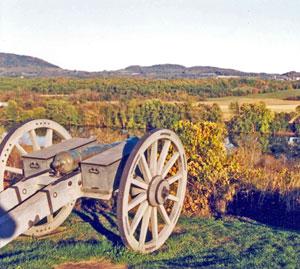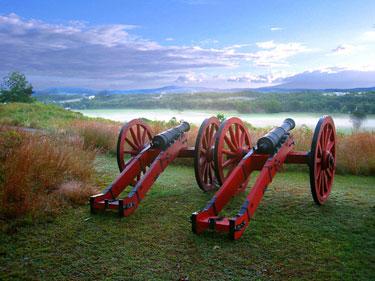The National Park Service manages dozens of sites of famous battles, and although every area has a unique story, many of them have something in common: lots of cannon. You may find them perched on redoubts, still facing a long-vanquished enemy, or resting sedately inside a museum, and perhaps you've wondered how all that ordnance managed to survive for all these years.
Some of that military weaponry is in fact original to the period, and those items are valuable indeed. Many such artifacts were lost long before there was any thought of national parks to commemorate battles, so reproductions of cannon and other ordnance are often used to fill in the gaps and help tell a park's story by recreating a sense of place.
The Story Behind A Cannon
There's a tale or two behind each piece of that historic hardware, and even some of the reproduction items have an interesting heritage. That's certainly the case for a cannon at Saratoga National Historical Park,and its background was told in an article written by Bill Meuse for the July 12, 1971, issue of the NPS Newsletter.
Here's a reproduction of his original story, "Ploughshares Into Swords - an Historical Precedent Repeated," which is available online at the National Park Electronic Library:
"Even as late as 1780, the Commonwealth of Virginia, like many of her sister colonies, was still searching for sources of warlike supplies and materiel. Most badly needed were items of heavy ordnance'cannon. The war was not going particularly well'a British army was rampaging the Carolinas, and Virginia's long and tortuous coastline was especially vulnerable. Virginia finally managed to purchase a number of cannon from Spain, and then opened negotiations with a foundry in France for the casting of iron cannon to order.
Striking A Bargain
The French foundry was more than willing to cast the guns for Virginia, but the negotiations came to a complete standstill over the matter of payment. The foundry was naturally quite unwilling to accept Continental or State script, and Virginia seemed unable to come up with the required amount in hard cash. A bargain was finally struck, and the foundry agreed that for every four pounds of iron delivered to it, one pound would be cast into cannon. Nothing more is heard of this peculiar agreement, and it may be assumed that the smashing victory at Yorktown and the resulting end of open hostilities put an end to Virginia's quest for foreign ordnance. The basic idea has merit, however, and has been resurrected.
Ordnance Needed
Saratoga, where victory made French assistance and the success at Yorktown a reality, is presently as desperate for ordnance as the "Old Dominion" ever was. With the bicentennial rapidly approaching and a battlefield yet to be reconstructed, no less than fifty cannon are required to rearm long silent emplacements, and these are not something that can be built overnight at the last minute.
We share a similar financial problem with many other parks in these troubled times in that our operating funds are completely inadequate to meet the needs. Cooperating Associations have provided a few of the needed cannon, but are incapable of assistance on the large scale required. Assistance, as was frequently the case during the Revolution, often comes too little or too late.
Scrap to Cannon
Last winter, shortly before the snow buried Saratoga under several feet of whiteness, we literally went on a "treasure hunt" around the park. As the park lands had been acquired, piece by piece, farms and homes had been bought up for the land and the buildings demolished. The woods were dotted with old cellar holes and foundations, filled with inconceivable junk. We knew where they were and had a pretty good idea as to what was in each one. Systematically we checked out the more promising ones, loading anything we found of cast iron onto a truck.
By day's end we had over a ton and a half of scrap iron, consisting of old automobile engine blocks, cast iron stoves, plow shares, farm machinery, grates, and a number of old cast iron signs left over from the days when we were a state park. The next day the truck headed for the foundry, and the load was turned over to them. In a short while they called us up and said we could have some of it back.
We went up and loaded a beautiful and newly cast 800-lb. six pounder cannon into the truck and brought her home. She has replaced an original piece on the battlefield, and now stands guard in the American defenses on Bemis Heights. So, we succeeded in cleaning up some unsightly spots in the park, came up with a good (albeit unusual) example of recycling scrap, and the end result was a badly needed product.

Cannon at the Great Redoubt, Saratoga National Historical Park. NPS photo.
So much for cannon barrels. Anyone know where we can get some carriages?"
In case you're not familiar with the term, the "carriage" is the wood and metal framework which supports the heavy cannon barrel; wheels on the carriage make it possible to reposition and transport the weapon.
During his career at Saratoga, Bill Meuse, the author of the above article, was responsible for obtaining a number of reproduction cannon which are still used at the battlefield--and which add immeasurably to the visitor experience.
Visiting Saratoga Battlefield Today
Saratoga National Historical Park is located in New York State, about 30 miles north of Albany. The park website summarizes the park's story: "Here in the autumn of 1777, American forces met, defeated and forced a major British army to surrender. This crucial American victory in the Battle of Saratoga renewed patriots' hopes for independence, secured essential foreign recognition and support, and forever changed the face of the world."
"Because of the incredible impact caused by the American victory in the Battles of Saratoga, they are known as the 'Turning Point of the American Revolution,' and are considered by many historians to be among the top 15 battles in world history."
You'll find more information about the park and details to help plan a visit, at this link. Among the activities you can enjoy is a driving tour of the battlefield, which includes a stop at Bemis Heights. There, overlooking the Hudson River Valley, you'll likely find a cannon or two... and perhaps the vestiges of some former plowshares.


 Support Essential Coverage of Essential Places
Support Essential Coverage of Essential Places







Comments
Thanks for a fascinating tale, Jim.
Great story but I'm left wondering how you managed to cut through all the red tape to get the cultural resources folks to sign off on the destruction of all those unsightly early 20th century artifacts. My understanding was the parks treat a pop bottle littered 50 years ago as a holy relic and that melting down signs from the 1930's would be unforgiveable heresy.
Thanks. I didn't read that article close enough.
Any discarded signs from the 1930's would have been less than 50 years old when the original story quoted above was written in 1971, so that time frame wasn't an issue. Even if it had been, perhaps there was a little more practicality back in the early 70s than there is today in determining what was scrap vs. what was "historic" :-)
Two of the most interesting examples of cannons you find at an NPS site are in Ft. Massachusetts on West Ship Island in the Gulf Islands National Seashore.
Mounted atop the fort is one of about twenty surviving examples of a fifteen inch Rodman cannon. These were the largest smooth bore cannons to be mass produced. (There is one twenty inch Rodman still mounted at Ft. Hammilton in Brooklyn.)
Even more fascinating is the big gun's twin on the south side of the fort shattered in several large pieces. When the government sold the obsolete guns to a salvage company they decided to make the job of removing the big guns easier by drilling into the cannons and packing the holes with explosives. Apparently trying to break the fifty-seven ton cannon into smaller pieces cost the salvor more than the metal was worth so they stopped their work leaving us one wonderful intact gun and providing the public a nice "exploded" view of the other.
There are several of those Rodmans at Ft. Zackary Taylor in Key West. The Army initially buried them to strengthen the fort walls but they were later dug up and restored. However, the cost to do so was enormous, so many remain buried.
Interesting posts, the EC comment on the buried cannons brought to mind a housing situation of mine in Yosemite National Park in 1971. The quarters were at 6500 feet, and a new all year road had been constructed (Highway 120 East, Hodgdon Meadows to Crane Flat, which opened in in 1967. Previously the area was in snowed in for the winter. Travel increased proportionately and it was decided to post a ranger. The house had no electricity or heat except for this wonderful old US Calvary stove, left over from the Army administration of the Park. The stove included heating coils so I had hot water. In any case, electricity was provided to the area in the middle seventies, making the stove obsolete. Interesting enough, in the upgrade of this cabin, the stove was not removed, it was just walled over. The current resident did not know what was behind the wall, but discovered that the stove was still there after I had mentioned it to her. She was quite interested. I am sure it is a true historic artifact, so it is still protected, in a fashion, after all these years.
Yeah ecbuck, I saw those at Ft. Taylor. I was down there for a job interview with the Florida Park Service. It was kind of a relief not to get the job when I thought about how to live in Key West on 25K a year.